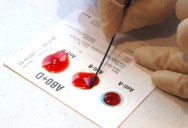Scientists Investigating Rare Antigens Discover An Entire New Blood Group
You probably know your blood type – A, B, O, and AB (both positive and negative) – which is determined by the presence or absence of specific antigens.
There are also lesser-known blood groups, though, which are more varied.

Image Credit: iStock
“The term ‘blood group’ refers to the entire blood group system, compromising red blood cell antigens whose specificity is controlled by a series of genes.”
There are actually 44 blood group systems, the latest of which was recently discovered at the University of Bristol.
Every group is distinguished by the way red blood cells group based on the antigens on their surfaces. The team in question was investigating a common collection of red call antigens named Er, which did not fit into any known blood group system.
The study was comprised of people with alloantibodies, which are antibodies that are specifically produced after exposure to foreign red blood cell antigens, and their gene-coding DNA sequences were analyzed.
The team of researchers found changes in the gene coding for the protein Piez01, which would cause an altered protein on the red blood cell surface. They further proved that protein was necessary for Er antigen expression, and establish that Er was its own blood group system that contained the previously recognized Era, Erb, and Er3 antigens, plus two new “high incidence” Er antigens called Er4 and Er5.

Image Credit: iStock
The research is important because the presence of alloantibodies can cause problems during transfusions where the donor and the recipient aren’t well-matched, and can also trigger immune system attacks during pregnancy.
Two of the new antigens, Er4 and Er5, are also associated with severe hemolytic disease of the fetus and newborn; during the study, two pregnant women miscarried due to this condition.
The authors hope that continued research could help develop tests for rare blood group types that could possibly prevent outcomes like those.

Image Credit: iStock
“This work demonstrates that even after all the research conducted to date, the simple red blood cell can still surprise us. Piezo proteins are mechanosensory proteins that are used by the red cell to sense when it’s being squeezed. The protein is present at only a few hundred copies in the membrane of each cell. This study really highlights the potential antigenicity of even very lowly expressed proteins and their relevance for transfusion medicine.”
They published their paper in Blood, the journal of the American Society of Hematology, and it sounds as if additional research could be on its way.

Sign up to get our BEST stories of the week straight to your inbox.




